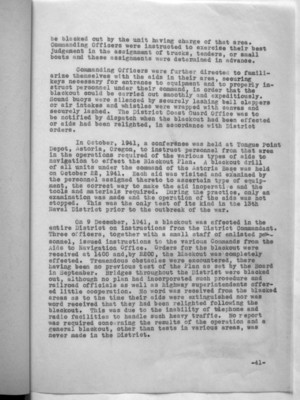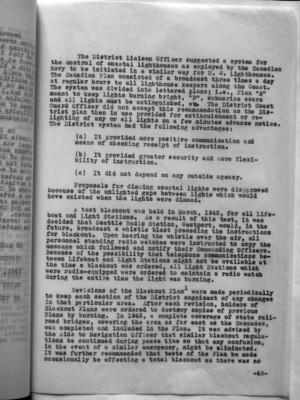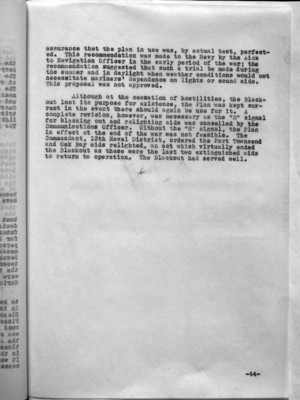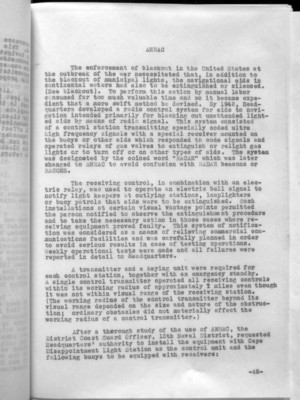Pages
61
be blacked out by the unit having charge of that area. Commanding Officers were instructed to exercise their best judgement in the assignment of trucks, tenders, or small boats and these assignments were determined in advance.
Commanding Officers were further directed to familiarize themselves with the aids in their area, securing keys necessary for entrance to equipment and to properly instruct personnel under their command, in order that the blackout could be carried out smoothly and expeditiously. Sound buoys were silenced by securely lashing bell clappers or air intakes and whistles were wrapped with canvas and securely lashed. The District Coast Guard Office was to be notified by dispatch when the blackout had been effected or aids had been relighted, in accordance with District orders.
In October, 1941, a conference was held at Tongue Point Depot, Astoria, Oregon, to instruct personnel from that area in the operations required of the various types of aids to navigation to effect the Blackout Plan. A blackout drill of all units under command of the Astoria Base was held on October 22, 1941. Each aid was visited and examined by the personnel assigned thereto to ascertain type of equipment, the correct way to make the aid inoperative and the tools and materials required. During the practice, only an examination was made and the operation of the aids was not stopped. This was the only test of its kind in the 13th Naval District prior to the outbreak of the war.
On 9 December, 1941, a blackout was effected in the entire District on instructions from the District Commandant. Three officers, together with a small staff of enlisted personnel, issued instructions to the various Commands from the Aids to Navigation Office. Orders for the blackout were received at 1400 and, by 2200, the blackout was completely effected. Tremendous obstacles were encountered, there having been no previous test of the Plan as set by the Board in September. Bridges throughout the District were blacked out, although no plan had incorporated such procedure and railroad officials as well as highway superintendents offered little cooperation. No word was received from the blacked areas as to the time their aids were extinguished nor was word received that they had been relighted following the blackout. This was due to the inability of telephone and radio facilities to handle such heavy traffic. No report was required concerning the results of the operation and a general blackout, other than tests in various areas, was every made in the District.
-41-
62
Because of the difficulties experienced by Lifeboat Station crews in extinguishing certain buoys in rough seas and strong tidal currents during this blackout, it was decided that if the buoys could be approached against the current at a distance of 10 or 12 feet, and a switch operated with a blow or push of a pole from a small boat, the buoy light could then be extinguished quickly under reasonable sea conditions. (Such a switch was later designed and installed on the lighted buoys on the approach to the Columbia River Bar.) As a further result of this blackout operation, a revision was made of the Blackout Plan, especially in the system of notifying civilian keepers and attendants as difficulty had been encountered in reaching these persons by telephone in their homes.
On December 10, 1941, shortly after the lights in the Columbia River Entrance Area had been blacked out, a distress signal was received from the SS MAUNA ALA which had run aground near the Columbia River Entrance about four miles south of South Jetty on Clatsop Beach. The SS MAUNA ALA, bound for Honolulu, had been out six days, and, at the declaration of war, had started back for Seattle under orders. The Master of the MAUNA ALA was not aware that the blackout of navigational lights was in effect. The million dollar cargo of Christmas effects, as well as the vessel itself, was a total loss. Lifeboat crews from Point Adams Lifeboat Station and Cape Disappointment Lifeboat Station, as well as the CGC ONANDAGA, assisted in the removal of the crew and Master. No lives were lost and no injuries sustained. In the investigation which followed, it was determined that the Master was at fault.
SS MAUNA ALA RAN AGROUND 10 DECEMBER, 1941, OFF THE OREGON COAST NEAR THE MOUTH OF THE COLUMBIA RIVER.
(image)
-42-
63
The District Liaison Officer suggested a system for the control of coastal lighthouses as employed by the Canadian Navy to be initiated in a similar way for U. S. Lighthouses. The Canadian Plan consisted of a broadcast three times a day at regular hours to all lighthouse keepers along the Coast. The system was divided into lettered plans; i.e., Plan "A" meant to keep lights burning bright, "B", submarine scare and all lights must be extinguished, etc. The District Coast Guard Officer did not accept this recommendation as the District plan then in use provided for extinguishment or relighting of any or all lights on a few minutes advance notice. The District system had the following advantages:
(a) It provided more positive communication and means of checking receipt of instruction.
(b) It provided greater security and more flexibility of instruction.
(c) It did not depend on any outside agency.
Proposals for dimming coastal lights were di(s)approved because of the unlighted gaps between lights which would have existed when the lights were dimmed.
A test blackout was held in March, 1942, for all Lifeboat and Light Stations. As a result of this test, it was decided that Seattle Radio Station, Westport, would, in the future, broadcast a whistle blast preceding the instructions for blackout. Upon hearing the whistle over the air, all personnel standing radio watches were instructed to copy the message which followed and notify their Commanding Officers. Because of the possibility that telephone communications between Lifeboat and Light Stations might not be available at the time a blackout was ordered, all Light Stations which were radio-equipped were ordered to maintain a radio watch during the entire time the light was burning.
Revisions of the Blackout Plan^1 were made periodically to keep each section of the District cognizant of any changes in that particular area. After each revision, holders of Blackout Plans were ordered to destroy copies of previous Plans by burning. In 1945, a complete coverage of state railroad bridges, covering the area as far east as the Cascades, was completed and included in the Plan. It was advised by the Aids to Navigation Officer that similar blackout regulations be continues during peace time so that any confusion, in the event of a similar emergency, might be eliminated. It was further recommended that tests of the Plan be made occasionally be effecting a total blackout as there was no
-43-
64
assurance that the plan in use was, by actual test, perfected. This recommendation was made to the Navy by the Aids to Navigation Officer in the early period of the war; the recommendation suggested that such a trial be made during the summer and in daylight when weather conditions would not necessitate mariners' dependence on lights or sound aids. This proposal was not approved.
Although at the cessation of hostilities, the Blackout lost its purpose for existence, the Plan was kept current in the even there should again be use for it. A complete revision, however, was necessary as the "S" signal for blacking out and relighting aids was cancelled by the Communications Officer. Without the "S" signal, the Plan in effect at the end of the war was not feasible. The Commandant, 13th Naval District, ordered the Port Townsend and Oak Bay aids relighted, an act which virtually ended the Blackout as these were the last two extinguished aids to return to operation. The Blackout had served well.
-44-
65
The enforcement of blackout in the United States at the outbreak of the war necessitated that, in addition to the blackout of municipal lights, the navigational aids in continental waters had also to be extinguished or silenced. (See blackout). To perform this action by manual labor consumed far too much valuable time and so it became expedient that a more swift method be devised. By 1942, Headquarters developed a radio control system for aids to navigation intended primarily for blacking out unattended lighted aids by means of radio signal. This system consisted of a control station transmitting specially coded ultra high frequency signals with a special receiver mounted on the buoys or other aids which responded to code signals and operated relays of gas valves to extinguish or relight gas lights or to turn off or on other types of aids. The system was designated by the coined word "RACAN" which was later changed to ANRAC to avoid confusion with RADAR beacons or RACONS.
The receiving control, in combination with an electric relay, was used to operate an electric bell signal to notify light keepers at outlying stations, lamplighters or buoy patrols that aids were to be extinguished. Such installations at certain visual vantage points permitted the person notified to observe the extinguishment procedure and to take the necessary action in those cases where receiving equipment proved faulty. This system of notification was considered as a means of relieving commercial communications facilities and was carefully planned in order to avoid serious results in case of testing operations. Weekly operational tests were made and all failures were reported in detail to Headquarters.
A transmitter and a keying unit were required for each control station, together with an emergency standby. A single control transmitter operated all receiving controls within its working radius of approximately 7 miles even though it was not within visual range of the receiving station. (The working radius of the control transmitter beyond its visual range depended on the size and nature of the obstruction; ordinary obstacles did not materially affect the working radius of a control transmitter.)
After a thorough study of the use of ANRAC, the District Coast Guard Officer, 13th Naval District, requested Headquarters' authority to install the equipment with Cape Disappointment Light Station as the control unit and the following buoys to be equipped with receivers:
-45-




